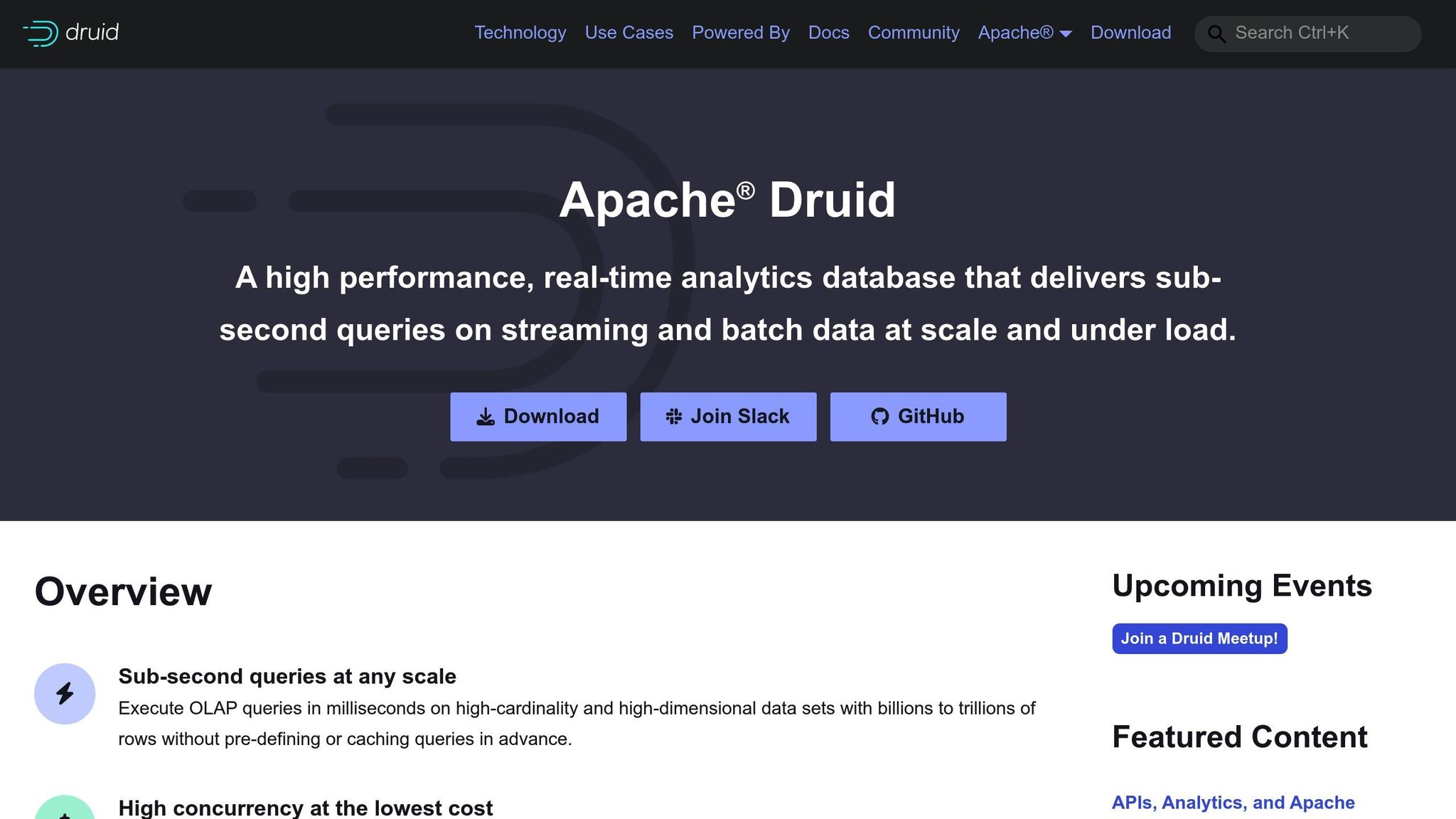Big data analytics platforms are essential tools for processing and analyzing large datasets, helping businesses make informed decisions. This study reviews how these platforms perform, focusing on speed, scalability, and usability for small and medium enterprises (SMEs) and scale-ups. Key takeaways include:
- Platform Types: Some, like Apache Druid, excel in real-time analytics, while others like Amazon Redshift are better for batch processing and managed cloud services.
- Features: Tools like Julius AI and Akkio simplify data processing with natural language queries and no-code interfaces, making them accessible to non-technical teams.
- Performance Metrics: Speed, scalability, and resource efficiency are critical for long-term success.
- AI Integration: Modern platforms embed machine learning for predictive insights and automation, enhancing decision-making without requiring deep technical expertise.
Choosing the right platform depends on your business's data needs, technical skills, and budget. Testing platforms through pilots can help ensure they align with your goals.
Key Performance Metrics for Platform Evaluation
Selecting the right big data analytics platform is a crucial decision, especially when performance is a top priority. While industry-standard metrics like response times, processing power, and scalability are often highlighted, there’s a noticeable gap in consistent, detailed benchmarks across platforms.
For small and medium-sized enterprises (SMEs) and growing businesses, relying solely on general research isn't enough. Conducting independent tests tailored to your specific needs can provide a clearer picture of which platform aligns with your current requirements and has the flexibility to handle future growth. These performance metrics lay the groundwork for the in-depth platform comparison we’ll explore in the next section.
Performance Comparison of Leading Big Data Platforms
When it comes to evaluating big data platforms, the lack of comprehensive benchmark data makes it tricky to draw direct comparisons. Instead, insights often come from industry observations, which highlight significant differences in how these platforms handle various data workloads. For small and medium-sized enterprises (SMEs) and growing businesses, these variations can play a major role in aligning platform capabilities with specific operational needs. This analysis aims to connect the dots between theoretical benchmarks and how these platforms perform in real-world scenarios.
Platform Analysis: Apache Druid, Apache Flink, and Others

Big data platforms vary widely in their strengths, depending on the type of workload they’re designed to handle:
- Apache Druid and similar platforms excel in real-time analytics, making them ideal for continuous data ingestion tasks like monitoring customer behavior or processing IoT data streams in real time.
- Batch processing solutions are better suited for handling large-scale, periodic data jobs. These platforms strike a balance between performance and cost, making them a solid choice for businesses focused on efficiency.
- Managed cloud services, such as Amazon Redshift and Google BigQuery, simplify operations with automatic scaling and reduced administrative overhead. However, their cost-effectiveness and performance often depend heavily on specific usage patterns.
Key Considerations
Choosing the right platform requires a careful evaluation of your unique needs. Here are some critical factors to keep in mind:
- Workload Demands: Does your business require low-latency, real-time query processing, or are you focused on efficient, large-scale batch analytics? The answer will guide your platform choice.
- Technical Expertise: If your team has the skills to manage and customize open-source solutions, they can offer flexibility. On the other hand, managed services provide ease of use but may limit customization options.
- Testing and Pilots: With limited benchmark data available, conducting pilot projects or targeted evaluations can help you identify the platform that best aligns with your specific requirements.
sbb-itb-bec6a7e
Current Trends in Big Data Analytics Platforms
The performance of big data analytics platforms remains a top priority, but the integration of AI and machine learning is adding a whole new dimension. These advancements are transforming the analytics landscape, offering tools that go beyond traditional reporting. For small and medium-sized enterprises (SMEs) and growing businesses, keeping up with these trends is essential to choosing the right platform and staying competitive.
AI and Machine Learning Integration
Big data platforms are now embedding AI features directly into their systems. This shift is moving analytics away from simple descriptive reporting and toward predictive and prescriptive insights - helping businesses make smarter, more automated decisions.
These platforms are increasingly equipped with machine learning capabilities for tasks like recognizing patterns, detecting anomalies, and forecasting trends. They also automate tedious processes like data cleaning, transformation, and feature engineering. On top of that, natural language processing (NLP) features allow users to interact with data using everyday language, making insights easier to access - even for teams without specialized data scientists.
In short, AI and machine learning are revolutionizing big data analytics platforms. They’re making advanced analysis tools more efficient and easier to use, particularly for SMEs and scale-ups looking to make data-driven decisions without a heavy lift.
Choosing the Right Platform for Your Business
When it comes to long-term success, selecting a platform that aligns with your business's performance goals is essential. Research shows that for SMEs and scale-ups, cost efficiency and scalability are top priorities. Platforms that support these needs can significantly improve key performance indicators and drive growth.
Key Factors for SMEs and Scale-Ups
Focus on automation. Platforms that streamline processes and cut down on manual work can save time and reduce costs. For example, in 2025, Mercado Libre, the largest e-commerce marketplace in Latin America, used Stability AI tools to create product visuals. This move led to a 25% higher click-through rate in their campaigns, proving how the right tools can directly impact revenue.
Look for deployment flexibility. Whether you need self-hosting, API integration, or cloud services, choose a platform that fits your operational style. Stride Learning, for instance, launched a storytelling app in just six months by using Stable Diffusion on Amazon Bedrock. The platform allowed them to generate over 1,000 images per minute, speeding up their development process.
Financial insights matter. Tools like Glean AI provide automated insights into spending, making expense management easier. Similarly, PolyAI uses AI-powered voice assistants to enhance customer service while cutting operational costs.
Consider tiered pricing models. Platforms offering free and premium options let businesses start small and scale as they grow. This is especially helpful for SMEs managing tight budgets while building their data capabilities.
No-code and low-code tools can be game-changers. These platforms allow non-technical team members to create and implement analytics solutions, reducing the need for specialized developers and speeding up deployment.
These factors can help guide your decision when choosing the platform that best supports your business goals.
Additional Resources and Tools
To find the right analytics platform, explore curated resources designed for SMEs and scale-ups. AI for Businesses (https://aiforbusinesses.com) is one such resource, offering a directory of AI tools tailored to improving operations. For example, Adzooma is an AI-driven marketing platform that optimizes ad campaigns across Google, Facebook, and Microsoft Ads. It automates ad management and provides actionable recommendations to boost performance.
The directory also includes tools like Looka, Rezi, Stability.ai, and Writesonic, helping you build a comprehensive tech stack to transform your business processes. By relying on vetted solutions, you save time and ensure you're choosing tools that meet your specific needs.
Ultimately, the best platform is one that evolves with your business, simplifies complex tasks, and delivers measurable improvements in performance.
FAQs
How do AI and machine learning improve the performance of big data analytics platforms for small and growing businesses?
AI and machine learning are transforming big data analytics by automating intricate data processing tasks. This not only speeds up the process but also delivers more precise insights. These technologies excel at spotting patterns, trends, and anomalies within massive datasets, empowering businesses to make smarter, data-driven choices.
For small and medium-sized enterprises (SMEs) and growing businesses, this translates to greater efficiency, lower operational costs, and sharper market trend forecasting. AI-powered tools can simplify tasks like customer segmentation, predictive analytics, and real-time decision-making, giving businesses a solid advantage in today’s fast-moving landscape.
What should small or medium-sized businesses consider when deciding between real-time analytics tools like Apache Druid and batch processing platforms like Amazon Redshift?
When deciding between real-time analytics tools like Apache Druid and batch processing platforms like Amazon Redshift, small and medium-sized businesses should evaluate their unique data processing needs and how quickly they require insights.
Real-time tools, such as Apache Druid, shine in situations where low-latency processing and instant insights are critical. For example, they’re perfect for monitoring live operations or tracking user behavior as it happens. In contrast, batch platforms like Amazon Redshift are designed to handle large-scale historical data analysis, making them ideal for businesses focused on strategic planning and long-term decision-making.
To make the right choice, consider factors like how quickly you need insights, the size and complexity of your data, and the type of analysis that aligns with your business objectives.
Why should SMEs run their own tests and trials before choosing a big data analytics platform, and how does this influence their decisions?
Testing a big data analytics platform independently allows small and medium-sized enterprises (SMEs) to evaluate how well it fits their unique business needs. It's a way to ensure the platform works smoothly with existing systems, can handle future growth, and meets day-to-day operational demands.
By conducting these tests, businesses gain valuable insights, reduce potential risks, and choose a solution that offers a stronger return on investment (ROI) and more effective data-driven results. Taking this hands-on approach lays the foundation for smarter decisions and sustainable growth.


